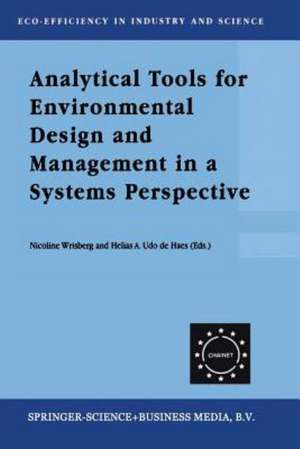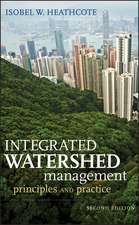Analytical Tools for Environmental Design and Management in a Systems Perspective: The Combined Use of Analytical Tools: Eco-Efficiency in Industry and Science, cartea 10
Editat de Nicoline Wrisberg, Helias A. Udo de Haes, Ursula Triebswetter, Peter Eder, R. Cliften Limba Engleză Paperback – 2 noi 2012
| Toate formatele și edițiile | Preț | Express |
|---|---|---|
| Paperback (1) | 640.24 lei 6-8 săpt. | |
| SPRINGER NETHERLANDS – 2 noi 2012 | 640.24 lei 6-8 săpt. | |
| Hardback (1) | 649.06 lei 6-8 săpt. | |
| SPRINGER NETHERLANDS – 31 mai 2002 | 649.06 lei 6-8 săpt. |
Din seria Eco-Efficiency in Industry and Science
- 9%
 Preț: 901.52 lei
Preț: 901.52 lei - 18%
 Preț: 951.29 lei
Preț: 951.29 lei - 15%
 Preț: 654.77 lei
Preț: 654.77 lei - 15%
 Preț: 648.42 lei
Preț: 648.42 lei -
 Preț: 391.61 lei
Preț: 391.61 lei - 15%
 Preț: 642.51 lei
Preț: 642.51 lei - 15%
 Preț: 643.34 lei
Preț: 643.34 lei - 18%
 Preț: 957.62 lei
Preț: 957.62 lei - 18%
 Preț: 953.35 lei
Preț: 953.35 lei - 18%
 Preț: 1238.74 lei
Preț: 1238.74 lei - 18%
 Preț: 1224.68 lei
Preț: 1224.68 lei - 18%
 Preț: 963.15 lei
Preț: 963.15 lei - 18%
 Preț: 2115.07 lei
Preț: 2115.07 lei - 18%
 Preț: 1388.53 lei
Preț: 1388.53 lei - 18%
 Preț: 1855.88 lei
Preț: 1855.88 lei - 18%
 Preț: 1234.94 lei
Preț: 1234.94 lei - 15%
 Preț: 643.00 lei
Preț: 643.00 lei - 15%
 Preț: 647.40 lei
Preț: 647.40 lei - 18%
 Preț: 1222.01 lei
Preț: 1222.01 lei - 15%
 Preț: 637.59 lei
Preț: 637.59 lei - 15%
 Preț: 648.42 lei
Preț: 648.42 lei - 15%
 Preț: 646.62 lei
Preț: 646.62 lei - 15%
 Preț: 645.79 lei
Preț: 645.79 lei - 20%
 Preț: 590.94 lei
Preț: 590.94 lei
Preț: 640.24 lei
Preț vechi: 753.22 lei
-15% Nou
Puncte Express: 960
Preț estimativ în valută:
122.51€ • 128.17$ • 101.77£
122.51€ • 128.17$ • 101.77£
Carte tipărită la comandă
Livrare economică 02-16 aprilie
Preluare comenzi: 021 569.72.76
Specificații
ISBN-13: 9789401039024
ISBN-10: 940103902X
Pagini: 292
Ilustrații: XII, 275 p.
Dimensiuni: 155 x 235 x 15 mm
Greutate: 0.41 kg
Ediția:Softcover reprint of the original 1st ed. 2002
Editura: SPRINGER NETHERLANDS
Colecția Springer
Seria Eco-Efficiency in Industry and Science
Locul publicării:Dordrecht, Netherlands
ISBN-10: 940103902X
Pagini: 292
Ilustrații: XII, 275 p.
Dimensiuni: 155 x 235 x 15 mm
Greutate: 0.41 kg
Ediția:Softcover reprint of the original 1st ed. 2002
Editura: SPRINGER NETHERLANDS
Colecția Springer
Seria Eco-Efficiency in Industry and Science
Locul publicării:Dordrecht, Netherlands
Public țintă
ResearchCuprins
I: Demand and supply of environmental information.- 1. Introduction.- 2. Demands for environmental information.- 3. Supply of environmental information for decision support.- 4. Analytical tools.- 5. Linking supply and demand concerning environmental information.- 6. Concluding remarks.- Al Aims of the electronic consumer goods case study.- A2 Description of the subject: electronic consumer goods.- A3 Demand side.- A4 Supply side.- A5 Linking demand and supply.- A6 Recommendations.- References.- Bl Aims of the automobile case study.- B2 Description of the subject: the automobile sector.- B3 Demand side.- B4 Supply side.- B5 Linking demand and supply.- B6 Recommendations.- B7 Additional information.- References.- CI Aims of the domestic clothes washing case study.- C2 Description of the subject: provision of clean garments.- C3 Demand side.- C4 Supply side.- C5 Linking demand and supply.- C6 Recommendations.- References.- Dl Life Cycle Assessment (LCA).- D2 Material Input Per unit of Service (MIPS).- D3 Environmental Risk Assessment (ERA).- D4 Material Flow Accounting (MFA).- D5 Cumulative Energy Requirement Analysis (CERA).- D6 Environmental Input-Output Analysis (env. IOA).- D7 Analytical tools for eco-design (matrices and checklists).- D8 Life Cycle Costing (LCC).- D9 Total Cost Accounting (TCA).- D10 Cost-Benefit Analysis (CBA).- Dll Cost-effectiveness analysis (CEA).- D12 Multi-Criteria Analysis (MCA).- El Introduction.- E2 Response.- E3 Characteristics of the overall response population.- E4 Preferences of the overall response population.- E5 Relationships between type of decision situation (question type) and preferences for certain tool characteristics.- E6 Relationship between occupational position and question type.- E7 Relationship between occupational position and preferences for certain tool characteristics.- E8 Some more findings.
Caracteristici
Includes supplementary material: sn.pub/extras






















